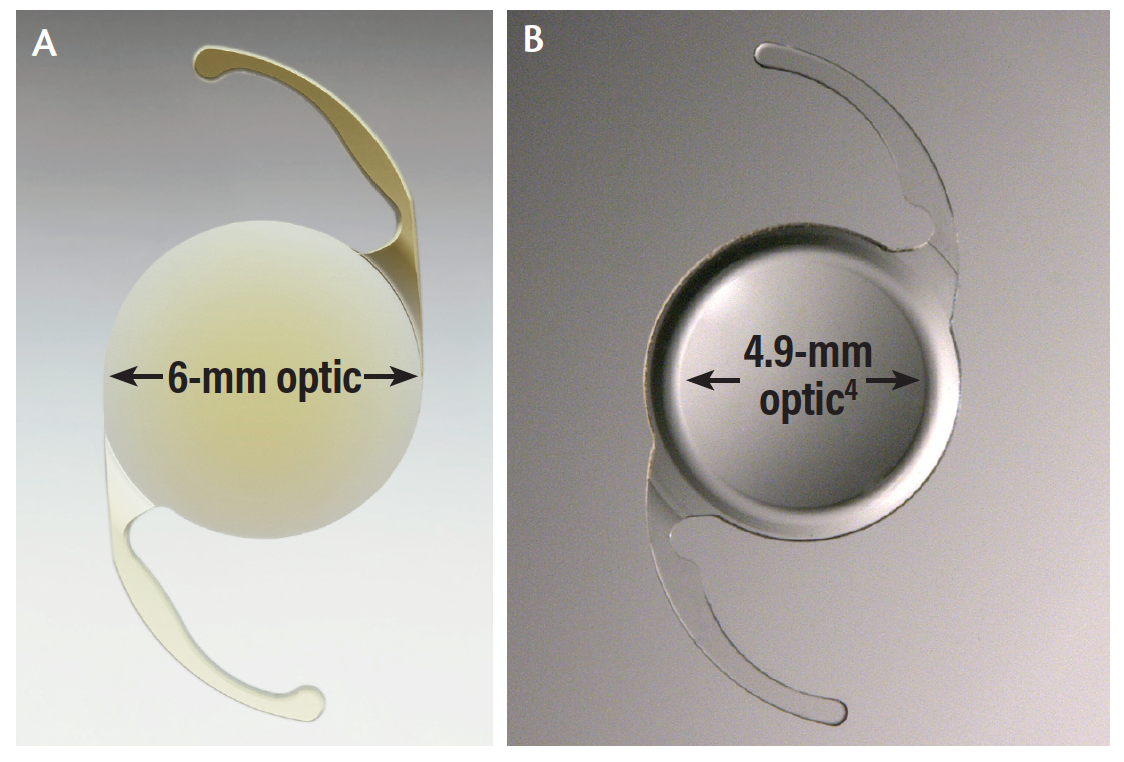When considering the landscape of currently available aspheric one-piece IOLs, the options may seem ubiquitous and interchangeable. However, after using the Tecnis* Monofocal 1-Piece IOL, (ZCB00, Johnson & Johnson Vision) and other lenses based on its platform, there are differences between the two that make the AcrySof IQ IOL (Alcon) my preferred lens platform.
spherical aberration
One difference between the lenses is the approach to correcting spherical aberration. The asphericity of the AcrySof IQ IOL is -0.20 um, which accounts for a precise amount of corneal spherical aberration and is designed to mimic the crystalline lens of a young adult.1 The Tecnis* 1-piece IOL has -0.27 um of spherical aberration.2
FULL-SIZED OPTIC
I like the fact that the AcrySof IQ IOL has a full-sized 6-mm optic that can easily pass through micro-incisions. In lens powers over +21.00 D, the Tecnis* 1-Piece 4.9-mm optical zone does not extend to the edge of the full 6-mm optic (Figure).3,4

Figure. The AcrySof IQ IOL (A) and the Tecnis* 1-Piece (B).
I prefer to use a 2.2- or 2.4-mm, temporally located, single-plane corneal incision. I can implant most AcrySof IQ IOL powers easily through a 2.2-mm micro-incision. Traditionally, the lower the refractive index, the thicker the lens, but the thin profile of the AcrySof IQ IOL helps make it extremely easy to implant.5
POSITIONING AND STABILITY
Another readily apparent difference between the two single-piece platforms is their haptic designs. My clinical impression is that the AcrySof IQ IOL is easy to handle. The BioMaterial with high fibronectin adhesion and the terminal haptic bulbs both can contribute to in-the-bag stability in vitro.5-7 Additionally, the haptic-optic angulation of the Tecnis* 1-Piece IOL places its optic plane posterior to the haptic plane. As the capsular bag compresses following implantation, the potential for the optic to move posteriorly may increase.4 Posterior movement of an IOL may result in a hyperopic shift and refractive surprises.4,5 Clinically, I prefer the axial stability of the AcrySof IQ IOL. The refractive predictability, in my hands, has been consistent across the entire AcrySof IQ platform.
In contrast, the single-piece zero-degree angulation design of the AcrySof IQ monofocal IOL adapts well to the contractile forces of the capsular bag and remains well-centered and stable in the eye. In my experience, its rotational stability is excellent, which is especially welcome when a patient has a compromised capsular bag or unstable zonular support. In challenging cases, when oriented in the axis of zonular deficiency, the AcrySof IQ IOL functions almost like a capsular tension ring, so I can feel comfortable knowing the lens is expanding and supporting the bag.
IMMEDIATE AND LONG-TERM SUCCESS
I have had excellent refractive predictability with the AcrySof IQ platform of lenses. The AcrySof IQ IOL delivers the refractive predictability and long-term stability that patients need. These patients have high expectations for immediate and long-lasting outcomes, and it would be unacceptable to have them return months or years later, after an initially successful surgery, because their lens has shifted and altered the refractive outcome.
With millions of AcrySof IQ IOLs implanted worldwide, competition is inevitable. The proven single-piece aspheric AcrySof IQ platform remains my go-to for its stability, ease of implantation, and consistent outcomes. Like it is for many surgeons, the AcrySof IQ lens remains my monofocal IOL of choice.
1. AcrySof IQ IOL Directions for Use.
2. Tecnis Monofocal 1-Piece IOL Directions for Use.
3. Radmall B, Floyd A, Oakey Z, Olson R. Refractive index and its impact on pseudophakic dysphotopsia. Clin Ophthalmology. 2015;9:1353-1358.
4. Alcon. Data on File.
5. Lane SS, Burgi P, Milios GS, et al. Comparison of the biomechanical behavior of foldable intraocular lenses. J Cataract Refract Surg. 2004;30(11):2397-2402.
6. Wirtitsch MG, Findl O, Menapace R, et al. Effect of haptic design on change in axial lens position after cataract surgery. J Cataract Refract Surg. 2004;30(1):45-51.
7. Ong M, Wang L, Karakelle M. Fibronectin adhesive properties of various intraocular lens materials. Alcon Laboratories, Fort Worth, TX,
USA. ARVO 2013.

